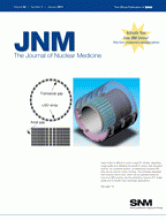About the Cover
Cover image

Head motion is difficult to avoid in long PET studies, degrading image quality and offsetting the benefit of using a high-resolution scanner. As a potential solution, simultaneously acquired MRI data can be used for motion tracking. The prototype dedicated brain scanner shown here, which can be operated inside the bore of an MRI scanner, has the potential to improve PET image quality and to benefit many neurologic applications.
See page 154.



